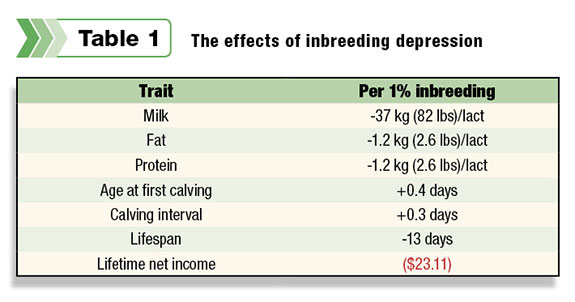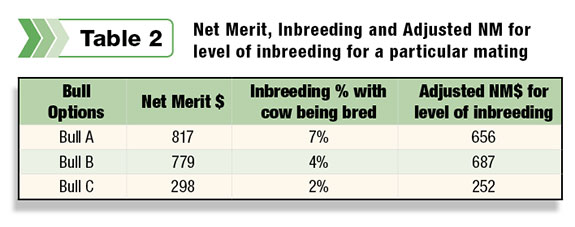Concerns associated with inbreeding have recently received more airtime than usual due to genomics. Read on to find some of my answers to frequently asked producer questions about this topic.
What is the best way to define inbreeding?
Inbreeding is a measure (or expected measure) of relationship between two individuals. Technically it is the percentage of genes that are identical by descent, meaning that an animal shares a copy of a gene from both the sire and the dam, which can be traced back through the pedigree to a common ancestor.
What is the difference between ‘inbreeding’ and ‘line-breeding’?
In principle, they are the same thing. “Line-breeding” describes focusing on certain lines or individual animals that have particular traits of interest. “Line-breeding” is a term generally associated with a planned mating or a conscious effort increasing the likelihood of particular genes or outcomes.
Race horses are a good example of this. “Inbreeding” is basically the same thing; however, there is usually a negative connotation associated with inbreeding because it often happens without planning. “Inbreeding” is a term commonly used to describe the negative effects of related matings on an entire herd or breed.
Why is there concern about inbreeding?
As animals get more related to each other, inbreeding depression occurs for certain traits, meaning performance is lower than expected. While this is not ideal, it must be weighed against genetic gain.

The trend for inbreeding is going up – are we reaching a critical level?
One of the most common misunderstandings about inbreeding is that there is not a critical level that we should exceed. There is no research supporting this claim. Instead, the effects of inbreeding depression appear to be linear according to Table 1 .
Therefore, going from 6 percent to 7 percent inbreeding has the same “cost” as going from 1 percent to 2 percent.
So with $23 per lifetime of reduced income, should I try to avoid inbreeding?
No, in my opinion, what we need to do is maximize profit. With $23 lifetime cost per percent inbreeding, it is easy to overreact and try to avoid inbreeding at all costs. But remember, one of the reasons breeds are becoming more related is because there are some really good genes in the population that have a highly favorable impact on profit as well.
Simply put, if we have one cow to breed and three sire options, one being an “outcross” or unrelated to the cow but genetically inferior, and another being highly inbred but a genetic standout, it is easy to see how the percent inbreeding is only one factor to consider.

In Table 2 , Bull B and Bull A are very close for genetic merit. However, when considering the mating of this particular cow to each of these two bulls, we must consider how the NM level will adjust based on the inbreeding of each mating.
In this example, Bull B will “re-rank” to have a better-than-expected outcome because the inbreeding level with the cow of interest is three percentage points less than that of Bull A.
A far genetically inferior bull, such as Bull C, will almost never re-rank to be higher than the other two sires. This example shows why “pedigree mating” is recommended, as it accounts for these adjustments.
Is the rate of inbreeding going up?
Yes, the rate of inbreeding has been increasing ever since the widespread adoption of A.I. in the 1950s and 1960s. This isn’t necessarily a bad thing. Very few producers would trade the productive cows of today for cows they had 25 years ago, even though today’s cows are more inbred. Today’s cows are more efficient, profitable production units due to selection for better and better genes through the use of A.I.
Is the extra attention on inbreeding in the genomic age warranted?
Before genomics, sires were usually 5 or more years old before they had widespread usage. However, with genomics, semen is widely used when a bull is as young as 14 to 15 months old. This change means the breeding age of daughters of a bull, and the age at which semen is available from sons of that same bull, are much more aligned.
Take, for example, AltaMETEOR. Some herds have daughters in their heifer breeding pens right now, and at the same time, the first AltaMETEOR sons now have semen available. This doesn’t change the inbreeding discussion, but it does mean that it should be a bit more carefully managed, as we certainly don’t want to breed a daughter of AltaMETEOR to one of his sons.
Will the use of genomic sires speed up the rate of inbreeding?
Yes, on a breed level it will, but we are also increasing the rate of genetic gain in an incredible way. So our goal should not be a “less inbred” cow but, instead, the most profitable cow. Over the past 25 years, we have created more inbreeding but also more profit. The same is true now with genomics, except that we should now expect both (inbreeding and genetic gain) to increase at a rate of two to three times what we experienced in the past.
Does this mean we can soon expect to get to 10 percent inbreeding level on a breed-wide basis?
Yes, and while geneticists are working on ways to balance the inbreeding level with genetic gain on a breed-wide basis, as a producer you should only be concerned with inbreeding versus genetic gain in your own herd.
What do the figures ‘EFI’ and ‘GFI’ mean?
EFI stands for “Expected Future Inbreeding.” To determine an EFI, scientists take a random sampling of animals in the breed and consider the effects of breeding a particular sire to each of those animals. The inbreeding level of each theoretical mating is then calculated and averaged across the entire sampling.
GFI stands for “Genomic Future Inbreeding.” GFI is determined the same way as EFI; however, it is more specific. GFI only considers the population that has been genomic tested and therefore can take into account genetic profiles instead of guessing which genes an animal received from its sire and dam. Neither figure is particularly useful for an individual herd.
Why are GFI and/or EFI not good indicators for measuring inbreeding for my herd?
A sire that is an “outcross” for your dairy might be highly inbred for another dairy. Take the example above from Table 1. Bull A (6.1 percent EFI) is a son of AltaMETEOR X Nifty and Bull B (6.3 percent EFI) is a Domain X Ramos. While their EFI is similar when mated to average animals in the breed, it may be highly different for your dairy compared to your neighbor’s dairy. If your dairy used AltaMETEOR widely a year ago, but you never used Domain or Ramos, evidently Bull B will be more of an “outcross” for your dairy than Bull A.
What traits does inbreeding have an effect on?
Increases in inbreeding are especially detrimental to health and fitness traits with some impact on production traits. If the industry was not measuring and selecting for these traits, we would need to be much more concerned about the negative effects of inbreeding. However, selection for traits like DPR, PL, SCS, CE and Stillbirths results in positive genetic gains for these traits. These gains more than compensate for the negative effects inbreeding has on health traits.
Has genomics helped find more outcross sires in the population?
Genomic selection has helped identify sires from cow families that were previously undiscovered. Yet while some less-related sires have been found, genomics has not diversified the breed thus far. This is because we are selecting for parts of the genome that have shown to have a positive effect on profitability. By doing this we no longer are selecting for animals per se, but instead for particular genes or SNPs and genomic selection favoring individuals that maximize the number of good genes.
What knowledge have we gained through genomics to help us with inbreeding?
If two animals look very unrelated on paper (through a pedigree analysis), that does not necessarily mean they don’t share many genes. Likewise, two animals that look related to each other can be significantly different on the genetic level, meaning they inherited many different genes.
While an individual animal inherits about 50 percent of its genes from its dam and 50 percent from its sire, the percentages can be far different than 25 percent from each grandparent because genes are usually inherited in segments rather than individually. With genomics we can make matings we know are unrelated based on the genomic profile instead of making matings we predict to be unrelated based on the pedigree.
Does this mean there is a new definition of outcross?
The word outcross is extremely difficult to define. An outcross is an animal that has a low level of relationship to the population. However, as described above, the population most producers should be concerned about is their population of animals. Geneticists, on the other hand, generally refer to the worldwide breed as the population. Therefore, the definition doesn’t change, but the application does.
What can I do to minimize inbreeding?
The two keys to minimizing inbreeding include accurate identification and using a mating program to assess the impact of inbreeding with each potential mating.
Accurate identification is essential to minimizing inbreeding. No mating scheme will minimize inbreeding without accurate identification.
Remember, as a producer your focus should be on maximizing profit as opposed to minimizing inbreeding. Accurate ID and an emphasis on profit, combined with the use of a mating program, will provide you with the peace of mind that profit potential has been maximized while minimizing inbreeding. PD

Nate Zwald
Senior Director of Global Strategy and Marketing
Alta Genetics







